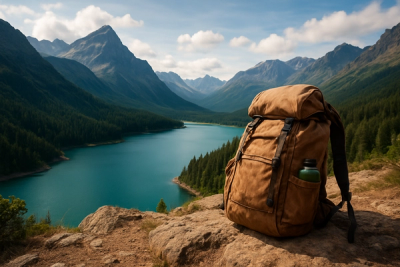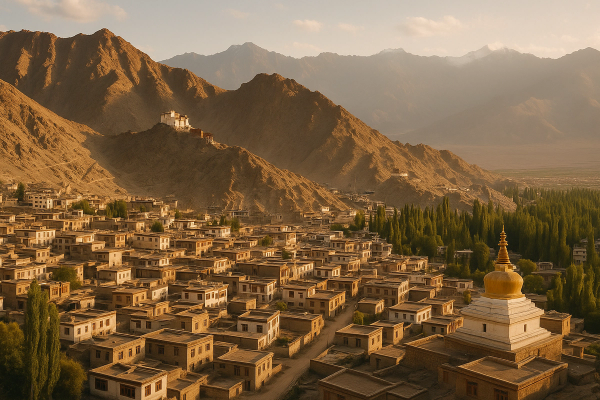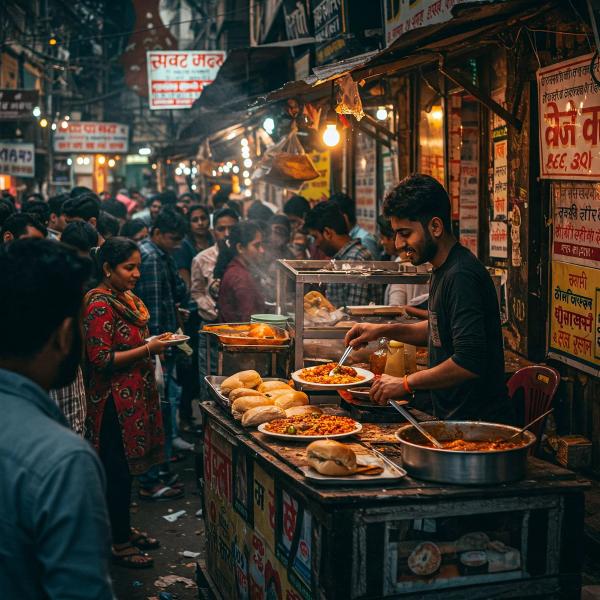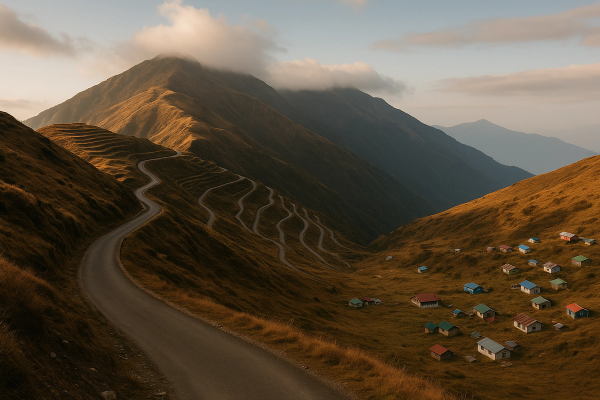Kutch White Desert: My Rann Utsav Travel Guide (messy, honest, 2025-ready)#
So, I finally did it. I went to the Rann Utsav, parked myself on that surreal, blinding-white salt desert in Kutch, and watched the moon rise like it was being dimmed up on a giant stage. I’ve wanted to go since…I don’t even know, since those postcard shots started stalking me on Instagram. And honestly? Standing out there at Dhordo with the wind throwing salt dust in my hair and a million people in neon jackets trying to take the same photo — it was still magic. Not Instagram magic. Real, stupidly beautiful, can’t-breathe-for-a-second magic. I took my shoes off and the ground crunched like snow but felt warm, then cold. You know that feeling when a place is too big for your head? Like that.¶
Why Rann Utsav wouldn’t leave my brain (and what 2025 changed)#
Dhordo got named one of the UNWTO Best Tourism Villages not long ago, and it shows. In 2025, it’s cleaner, slicker roads, more signs (thank the travel gods), and better lighting on the approaches. Also, more people. Like, a lot. The culture showcase still feels homegrown though — Kachchhi folk songs drifting out from the tent city stage, aunties selling mirrorwork everything, craft demos that aren’t just for show. And the white desert — the “White Rann” — is exactly as wild as the photos, except it plays games with your eyes. Hot at noon, bone-cold after sunset, flat and endless until you suddenly spot, way out, a BSF guy waving you back because you wandered too close to a restricted patch. Borderland vibes are real. 2025 also brought faster data (Jio’s 5G reaches the approach, then drops; don’t bet your drone footage on it), cashless payments everywhere (UPI QR codes even at chai stalls), and slightly higher prices compared to 2023-24. Inflation, sigh.¶
How I got there (planes, trains, trying not to get lost) in 2025#
I flew into Bhuj — tiny airport, one baggage belt, the whole cozy deal. Schedules change a lot, so just double-check a week before; flights are usually from Ahmedabad and sometimes Mumbai, but the timings are weird, especially off-peak weekdays. Trains are solid: the Kutch Express from Mumbai to Bhuj, plus a few from Ahmedabad. Pro tip: if you’re the type who doesn’t sit still, book a sleeper and make it a night move — get in early, hire a cab, and hit the Rann before sunset crowds. Bhuj to Dhordo is about 80 km; my taxi cost me around INR 3,200 one way in January (driver waited for chai because of course). There are seasonal buses to Dhordo during the festival, but they’re not super frequent and you’ll still need a last-mile tuk-tuk. Google Maps got dramatic and took me down a side road once; ask a human in Bhirandiyara if you’re unsure. People there are absurdly helpful.¶
Permits, timing, and the weirdly satisfying stamp you get#
You need a permit to enter the White Rann because it’s a sensitive border zone. In 2025 the process is mostly online (rannpermit.gujarat.gov.in when it behaves), but I’ve also gotten it at the Bhirandiyara check post in like 10 minutes with an ID copy. It’s usually around INR 100–150 per adult, plus a small vehicle fee — carry some cash because the card machine sleeps. Keep your ID handy for the BSF gate near Dhordo. Entry for sunset gets busy: they start letting people in by late afternoon and nudge everyone back after moonrise unless it’s a full moon night, when timings are stretched. If you want that pink-sky-cotton-candy moment, be at the gate by 4 pm on weekends. On weekdays, less fuss. Oh, and don’t wander off the marked area — some patches look dry and then your foot sinks. Happened. Salty socks for days.¶
Where I stayed (and what I’d do different next time)#
I did one night in Tent City Dhordo and one in a Hodka village homestay, and I’m glad I split it. Tent City is the all-in-one theme-park version with meals, cultural shows, guided sunset-sunrise shuttles, the works. Prices in the 2024–25 season jumped a bit — think roughly INR 7,000–12,000 per person per night in the basic/deluxe tents on weekday promos, and INR 12,000–22,000+ on peak dates or premium tents and suites. The 2N/3D packages (with transfers and sightseeing) hover around INR 25,000–45,000 per person depending on tent category and dates. They keep tweaking dynamic pricing, so yeah, book early or stalk deals mid-week. The homestay in Hodka cost me about INR 3,500 per person including dinner and breakfast — rustic, round mud bhunga with mirror art walls, no glossy frills, and easily my favourite night because the stars felt closer and I could actually hear the wind, not a speaker.¶
Okay, what I actually did (and what I messed up)#
First evening: sunset at the White Rann. The world turned sherbet orange, and everyone cheered for absolutely no reason except… sunset. I joined. Then I waited for the moon. Full-moon nights are ridiculous, like a stadium light turned on over a white runway. I didn’t bring tripod, dumb move, but I propped my phone on a water bottle and got one crisp shot. Second day I hit Kalo Dungar (Black Hill) for that aerial view where the Rann becomes this cracked porcelain plate. Early morning is best — parking fills fast after 9. Then Nirona village for Rogan art (the real-deal family atelier takes time to explain; buy something if you can, it keeps the craft alive). Back at Dhordo, I ate too many bajra rotlas at lunch then tried an ATV ride on the salt edge (INR 600-ish) and a paramotoring experience just before dusk (prices were around INR 3,000–4,500 for 5–7 minutes… short but the view, wow). Camel carts are still there, touristy, sweet, about INR 200–400 depending on how you haggle. Night shows in Tent City were a blast — Garba circle pulled me in, I looked like a scarecrow, no regrets.¶
Side trips I loved (and one I’d skip if short on time)#
Mandvi Beach is a day trip from Bhuj, and if you need a break from salt and white — bam, blue and breezy. Vijay Vilas Palace is cinematic, plus warm samosas nearby. Bhuj itself is worth half a day: Prag Mahal’s towering hall, the Aina Mahal museum bits (check current renovation status before you go), the Swaminarayan temple gleaming in the sun, and the heart-melty street food around Jubilee Circle. Lakhpat Fort and the gurudwara are stunning but far — I’d only do it if you’ve got time for a long drive and a quiet, contemplative day. The skip? Random "salt desert sunset point" boards on side roads that lead to soft marsh — if there’s no official gate or permit check, just… don’t.¶
Food that made me happy (and sleepy) in Kutch#
Kutchi food is comfort food with swagger. Think bajra rotla smeared with ghee, lehsun chutney that could power a small village, kadhi that tastes like home even when it isn’t yours, khichdi that hugs back. I had a massive thali in Bhuj for like INR 300 that included two sweets and I still daydream about it. Dabeli in Kutch is different — spicier, crunchier, more peanuts. Jalebi-fafda for breakfast because why not. Chhaas in steel glasses. Late-night pistachio kulfi near Bhuj bus stand. And in the villages, you’ll sometimes get milk fresh from the buffalo that morning. If you’re vegetarian you’ll be thrilled; if you’re vegan, say it clearly — ghee sneaks in everywhere. Hydrate a ton. The air’s dry, you don’t notice how much you’re losing until your lips crack, and then you look like a raisin in photos.¶
2025 practical stuff: visas, permits, payments, and random things nobody tells you#
Visas first: Most nationalities now use India’s e-Visa system for tourism — apply online and get approval by email, typically in a few days. In 2025, Voice of reason says apply at least a week out because occassionally there’s a hiccup and you don’t wanna sweat at the airport. Visa-on-arrival is limited (Japan, South Korea, and certain UAE nationals under specific conditions); everyone else should do e-Visa. If you’re Canadian or Chinese, the suspensions and pauses from the past are over — services were restored before 2025, but still double-check the official portal because rules do wobble sometimes. You’ll do biometrics on arrival. Keep your hotel address handy. For the White Rann, you still need the local entry permit (online or at Bhirandiyara) plus your passport/ID at the BSF gate. Payments: UPI is king in Gujarat and it’s finally workable for many foreign visitors in 2025 via prepaid forex cards linked in participating apps, or just carry a local SIM and a bank card that plays nice. Cards work at Tent City and bigger shops; in villages, cash is faster. Connectivity: 4G is fine in Bhuj, patchy on the Rann itself; 5G shows up then vanishes like a mirage. Weather: Nov–Feb can swing 28°C day to 8°C night — pack a warm layer, a hat, and lip balm. Monsoon (Jul–Sep) the flats are underwater and Rann Utsav doesn’t run. Drones are a nope unless you’ve got proper permissions — border zone, remember. Travel insurance? Yes. The nearest good hospital is in Bhuj, and the desert won’t cuddle you if you twist an ankle.¶
What it costs in 2025 (rough, honest, and totally depends on you)#
If you do two nights in style at Tent City on a weekday: say INR 30,000–40,000 per person for the package with meals and sightseeing. Add INR 6,000–7,000 for taxis round-trip Bhuj–Dhordo and maybe INR 1,000 for permits and random snacks. Toss in activities: ATV 600, paramotor 3,500, souvenirs 2,000 (or 20,000 if you go berserk on rogan art like me). A comfy homestay version: 2 nights at INR 3,000–4,500 per person per night including meals, plus a rental car or driver for day trips (INR 3,000–4,000 per day). Budget travelers can do Bhuj guesthouses for INR 800–1,500 a night and share jeeps/buses to the Rann; still worth it, just build time for the logistics. Prices have crept up 8–15% since pre-2023. Weekdays are cheaper, full-moon nights are premium, and long weekends in Dec–Jan are bananas unless you book early.¶
When to go (full moon is not the only good answer)#
Everyone screams “full moon” and yeah, it’s special. The salt glows like it’s lit from inside. But new moon nights are wild too — the sky is darker, more stars, and the Milky Way does a shy hello if the air’s clear. Sunrise is my sleeper pick: fewer crowds, icy breeze, and pastel colors you don’t get at sunset. If you’re trying to dodge the rush, aim mid-week in late November or late January. December 24–Jan 2 is a circus. If you’re planning 2025, check the lunar calendar and book months in advance if you’re set on that full-moon slot. And — tiny hack — arrive a day before the full moon and catch the moonrise the night prior; it’s almost as bright and way calmer.¶
Stuff I wish I knew before I went (learn from my nonsense)#
- White clothes look cool in photos but get salt stains. Wear off-white or beige. Or don’t, and embrace the crusty look.
- Take a scarf/buff. Salt dust + wind + lip balm = you’ll thank me.
- Book taxis in Bhuj in advance on peak dates — rates shoot up day-of.
- If you buy crafts, ask politely who made it. The village co-ops are legit and your rupees go to the right folks.
- Don’t step anywhere wet-looking on the Rann. Looks solid, isn’t. I did a slo-mo slide that lives rent-free in my friends’ group chat.
The culture hit me hardest (and I didn’t expect that)#
I know people come for the drone-shot moonscapes, but it’s the people that slammed into my heart. An old musician outside the Hodka chowk tuned his jodia pava and played a melody that sounded like wind over empty land. A craftswoman stitched mirrors into a flamingo pattern while telling me how the designs are memories of seasons. The night I stayed in the bhunga, the family’s little boy peeked in shyly and asked where I was from, and when I said “Mumbai,” he said, “too many cars” and offered me a date. It was sticky-sweet and perfect. Travel advertises the grand view; Kutch delivers the small kindness.¶
Safety and sustainability (2025 reality check)#
It’s safe, broadly — Gujarat is hospitable, and festival staff keep things organized. Watch your stuff at crowded gates, normal city smarts. The Rann is fragile, though. Don’t litter. Single-use plastics are frowned upon and sometimes outright banned at checkpoints — carry a refillable bottle. Stick to marked tracks; tire ruts mess the crust and it’s not cool. Weather swings are real. December nights are genuinely cold in the open; people underestimate it and end up shivering through the cultural show in thin shirts. Heatwaves are getting weirder in shoulder months (I felt a 33°C afternoon in late Nov that wasn’t normal), so sunblock, hat, electrolytes. And yeah, no drones without paperwork — it’s a border zone policed by BSF, not a beach party. Also, stargazing tip: walk just 3–5 minutes away from the main crowd with a torch and then switch it off. The sky deepens, your ears find the quiet, and you’ll feel tiny in the best way.¶
Connectivity, cash, and tiny hassles that add up#
SIM cards: you can buy in Bhuj with passport and visa; eSIMs are convenient if your provider supports India. Data’s cheap. Signal on the Rann itself… meh. Offline maps, download them. ATMs exist in Bhuj, not so much in Dhordo. UPI QR codes are everywhere now, and many foreigners in 2025 can use UPI via a travel wallet setup, but I still carried INR 3–4k cash and it made life easier. Public toilets at the festival zone are okay-clean but bring tissues and sanitizer. Shade is sparse — a cap or light shawl is your best friend. And footwear: closed shoes for the salt (it’s not a beach). It’s like walking on frosted glass made by aliens; looks soft, isn’t.¶
If you only have 36 hours, do this#
- Catch the afternoon bus/taxi from Bhuj, snag your permit at Bhirandiyara, and hit the Rann for sunset. Stay in Dhordo (tent or homestay).
- Pre-dawn chai, back to the Rann for sunrise. After breakfast, drive to Kalo Dungar, then swing by Nirona for rogan art.
- Late lunch in Bhuj, do Prag Mahal + a thali, shop crafts near Bhujodi if you’ve got energy, then train/flight out.
Would I go back? Immediately, yes (and here’s my take)#
I’d go back on a new-moon weeknight with a bunch of friends and a flask of hot chai, and I’d do two nights in a village stay instead of the tent city. I’d carry a proper tripod, extra socks, and more patience for the gate queue. I’d spend more time listening than photographing — Kutch is one of those landscapes where the sound of the wind feels like a language you haven’t learned yet. Rann Utsav can be flashy, sure, but under the lights, there’s a quiet heartbeat that’s older than every stage and selfie. When you catch that, the trip sticks to your bones.¶
Final tiny tips before you book (and a thank you)#
Check the lunar calendar, book weekday nights if you can, layer up, hydrate more than feels normal, don’t chase the far horizon on foot, and leave a little room in your bag for crafts because you will buy something mirror-y. Keep copies (digital and paper) of your ID for permits. If you’re sensitive to dust, a mask helps — the salt powder gets feisty when the wind picks up. And, um, eat another dabeli for me. If you want more messy, lived-in travel stories or to deep-dive a destination before you go, I keep ending up on AllBlogs.in — it’s got that rabbit-hole vibe for planning and daydreaming both.¶














